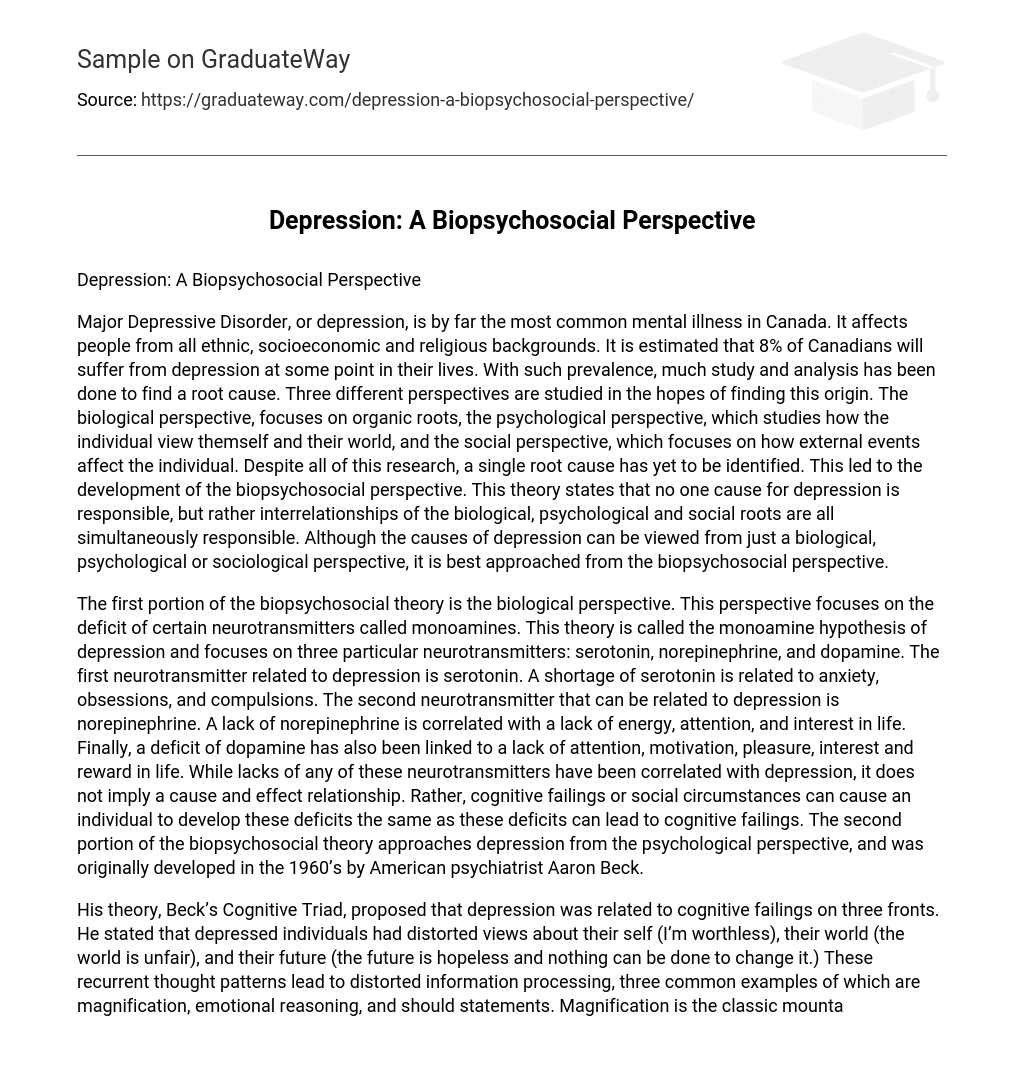Major Depressive Disorder, or depression, is by far the most common mental illness in Canada. It affects people from all ethnic, socioeconomic and religious backgrounds. It is estimated that 8% of Canadians will suffer from depression at some point in their lives. With such prevalence, much study and analysis has been done to find a root cause. Three different perspectives are studied in the hopes of finding this origin. The biological perspective, focuses on organic roots, the psychological perspective, which studies how the individual view themself and their world, and the social perspective, which focuses on how external events affect the individual. Despite all of this research, a single root cause has yet to be identified. This led to the development of the biopsychosocial perspective. This theory states that no one cause for depression is responsible, but rather interrelationships of the biological, psychological and social roots are all simultaneously responsible. Although the causes of depression can be viewed from just a biological, psychological or sociological perspective, it is best approached from the biopsychosocial perspective.
The first portion of the biopsychosocial theory is the biological perspective. This perspective focuses on the deficit of certain neurotransmitters called monoamines. This theory is called the monoamine hypothesis of depression and focuses on three particular neurotransmitters: serotonin, norepinephrine, and dopamine. The first neurotransmitter related to depression is serotonin. A shortage of serotonin is related to anxiety, obsessions, and compulsions. The second neurotransmitter that can be related to depression is norepinephrine. A lack of norepinephrine is correlated with a lack of energy, attention, and interest in life. Finally, a deficit of dopamine has also been linked to a lack of attention, motivation, pleasure, interest and reward in life. While lacks of any of these neurotransmitters have been correlated with depression, it does not imply a cause and effect relationship. Rather, cognitive failings or social circumstances can cause an individual to develop these deficits the same as these deficits can lead to cognitive failings. The second portion of the biopsychosocial theory approaches depression from the psychological perspective, and was originally developed in the 1960’s by American psychiatrist Aaron Beck.
His theory, Beck’s Cognitive Triad, proposed that depression was related to cognitive failings on three fronts. He stated that depressed individuals had distorted views about their self (I’m worthless), their world (the world is unfair), and their future (the future is hopeless and nothing can be done to change it.) These recurrent thought patterns lead to distorted information processing, three common examples of which are magnification, emotional reasoning, and should statements. Magnification is the classic mountain out of a mole hill, while emotional reasoning is viewing negative personal images as fact, for example, I feel stupid, and therefore I am stupid. Finally should statements are when one expects a person to do what they should all the time, regardless of the present circumstance or situation. For example, if an individual had several assignments due at the same time, and one wasn’t to the standard they felt it should have been, despite having a massive workload, they would become very upset over the one assignment, instead of being proud that they finished all of them. Albert Ellis called this ‘mustrubation.’ Finally, the third portion of the biopsychosocial perspective studies depression from a sociological perspective. It posits that many different social situations, starting in early childhood and continuing through life can be linked to depression. Children raised in a negative environment are at a significantly higher risk of depression, and mental health issues in general. Being raised in an abusive environment, poverty or in social isolation are some of the possible situations that can lead to mental illness, as can a parent having a mental illness, or the death of a parent.
Stressful events in adult life can also cause depression. Job loss, divorce, or the death of a friend or family member can all cause depression, or exacerbate the biological and psychological roots to a diagnosable level. Depression can be treated from any one of these perspectives, but for effective treatment, all three must be treated simultaneously. If an individual is treated solely from the biological basis, their psychological and sociological failings will most likely still keep the person depressed. The same result may happen if any of the roots are treated in vacuum. Rather, for the most effective treatment, an individual should be treated from all three perspectives simultaneously. The efficacy of simultaneous treatment is the most overwhelming proof that the biopsychosocial perspective is the most correct model of the roots of depression.





